Doro Wat (Spicy Ethiopian Chicken Stew)
This post may contain affiliate links. See my disclosure policy.
There is a reason why Doro Wat is the national dish of Ethiopia and one of the most famous of all African dishes – it’s fabulous! This authentic Doro Wat recipe captures the very best of Ethiopian cooking!
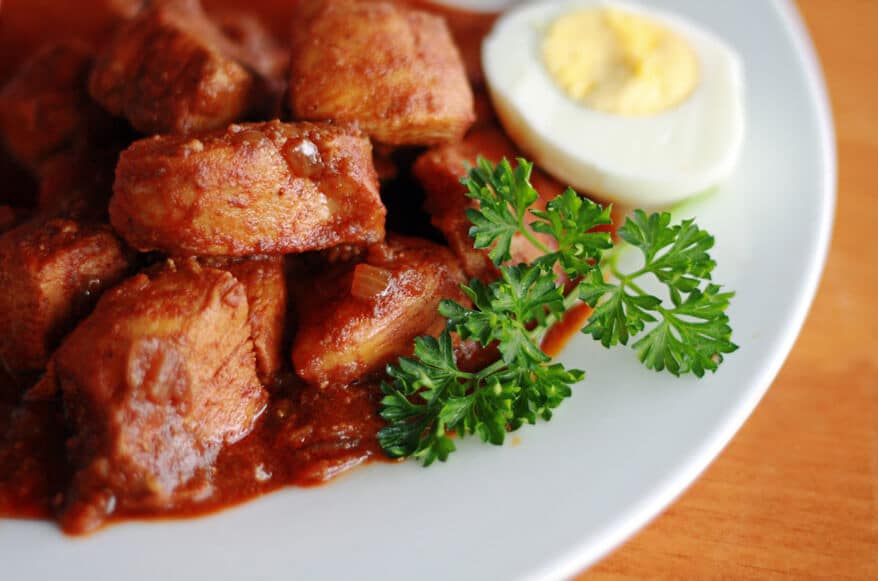
Doro Wat is one of the most famous of all African dishes. You will find it in every Ethiopian restaurant and virtually anyone who is familiar with African cuisine will have heard of it. Another version, though not as commonly known here, is Sega Wat, made with beef (fyi, you’ll find recipes online calling it Sik Sik Wat, but I’ve confirmed with the chefs of several Ethiopian restaurants that it’s Sega Wat). You can directly substitute beef for chicken and follow the same cooking instructions.
Doro Wat is traditionally made very spicy. Super spicy. Like I-don’t-know-how-Ethiopians-have-any-taste-buds-left spicy. Western adaptations are still spicy, but quite tame compared to the real deal.
This recipe for Doro Wat comes by way of request from Jared (Make a Request!). He said he has been trying for several years to find a good recipe. Jared, this recipe is both authentic and delicious – I think you’ll be very happy with it!
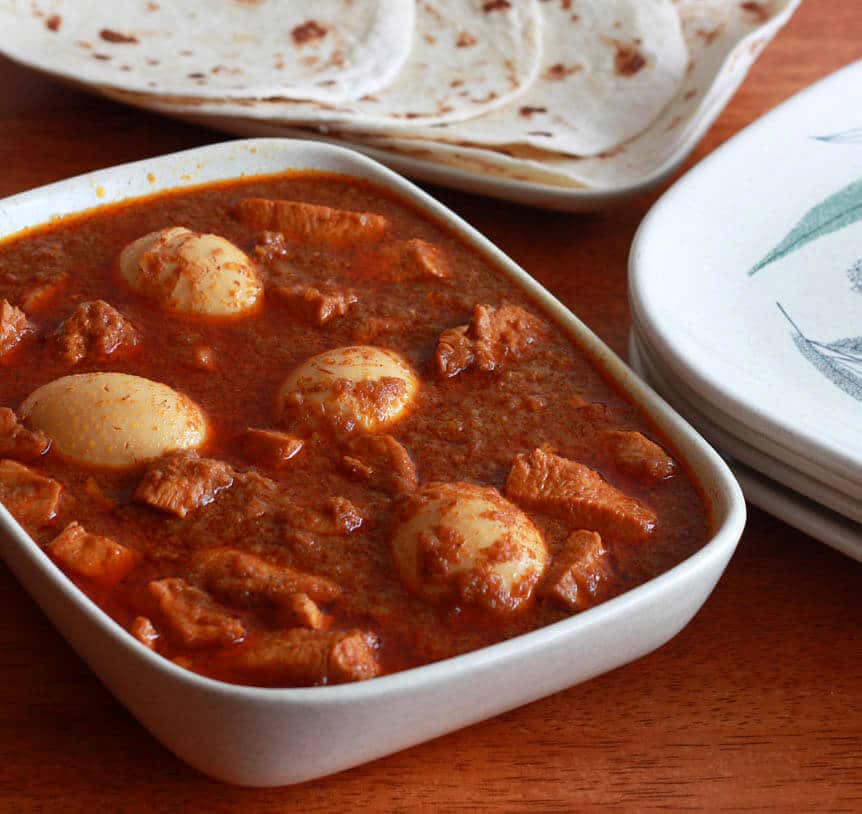
Traditionally Doro Wat is served with an Ethiopian flatbread called injera. It’s kind of a spongy pancake made with teff flour (a grain indigenous to the area), and the batter is left to ferment for up to 4 days before its used. The injera is used in place of an eating utensil and is used to scoop up the chicken stew.
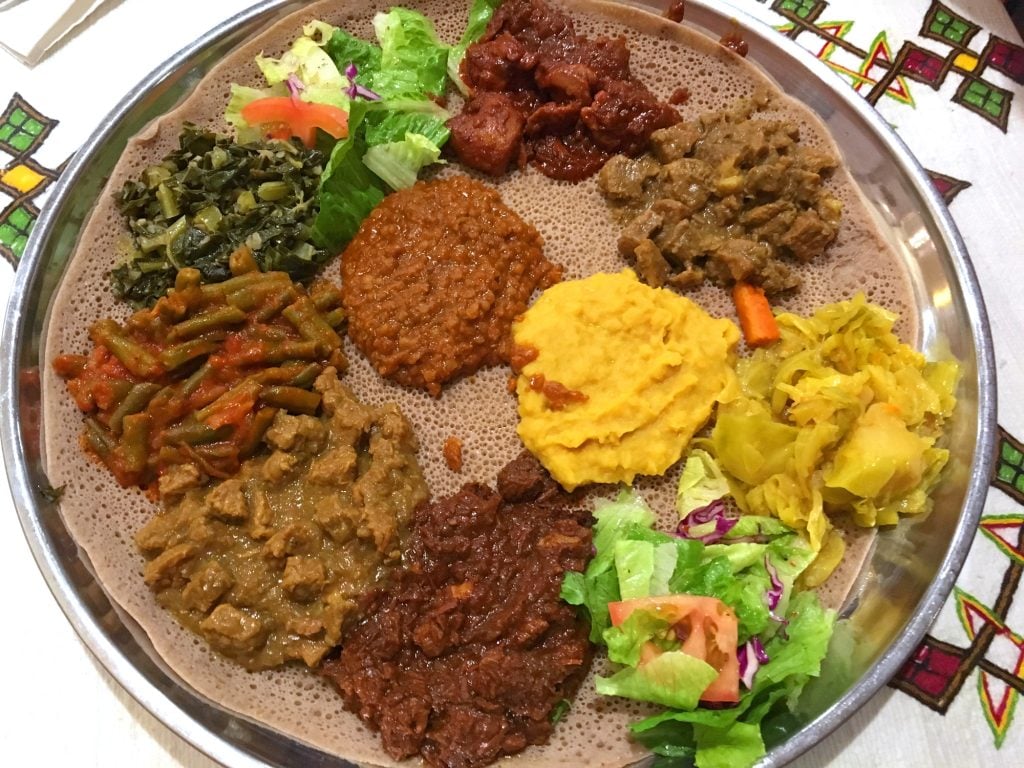
Doro Wat Key Ingredients
The key to authentic, great-tasting Doro Wat is good quality, flavorful berbere, and a very long cooking process. It can take several hours for an Ethiopian to make Doro Wat. You can cut back on the cooking time and your Doro Wat will still taste good, but it won’t taste like it’s supposed to. The magic is in the slow-cooked onions. And it takes time for the magic to happen.
A central ingredient of Doro Wat is Berbere, a fiery, bright red and flavorful Ethiopian spice blend. It is best made fresh using whole spices that are toasted and ground for maximum flavor. A combination of whole and ground spices are used as seen in the picture below.

The whole spices are toasted and ground up with the already ground spices to make a beautiful, aromatic, flavorful and spicy seasoning blend.
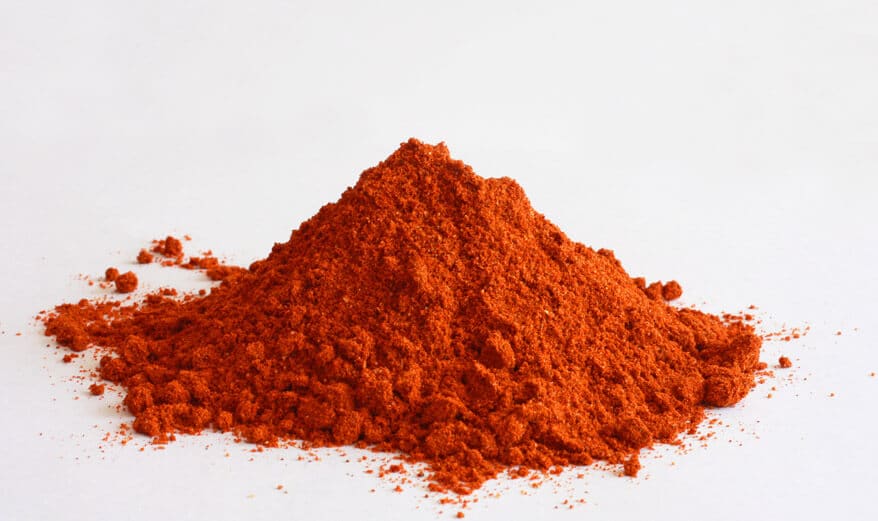
Purchasing these spices will serve you well as each of them are commonly used in a large variety of other cuisines. Stored in airtight glass jars in a dark place, they will keep a very long time. If you’d rather purchase berbere, you can find it online. You need 1/4-1/3 cup for this recipe alone, so forget the tiny 2-3 oz jars of it you usually find for sale. The best deal I’ve found for bulk berbere (and it also happens to be organic and a reputable brand) can be found HERE.
Berbere makes a great rub for meat, poultry, and fish, as well as a seasoning for stews, soups, and vegetables. It’s a great all-purpose spice, so you’ll be able to make good use of this bulk package if you decide to buy versus make your own.
Another key ingredient in Doro Wat and Ethiopian cooking at large is niter kibbeh, a seasoned clarified butter. You can find it in Indian grocery stores and well-stocked Asian markets, but as always I strongly recommend making your own for the best flavor. Check out my recipe for homemade Niter Kibbeh!

Doro Wat Recipe
Let’s get started!
Use a food processor to very finely mince the onion – you want an almost chunky puree.
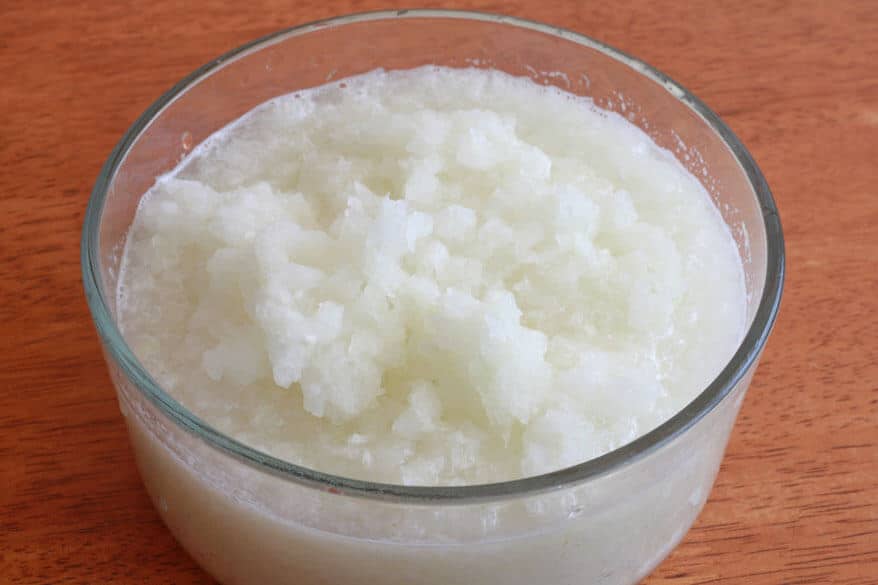
Heat 2 tablespoons of oil and 2 tablespoons of niter kibbeh in a Dutch oven and saute the onion, covered, over low heat for 45 minutes, stirring occasionally. Add more niter kibbeh if it gets too dry.
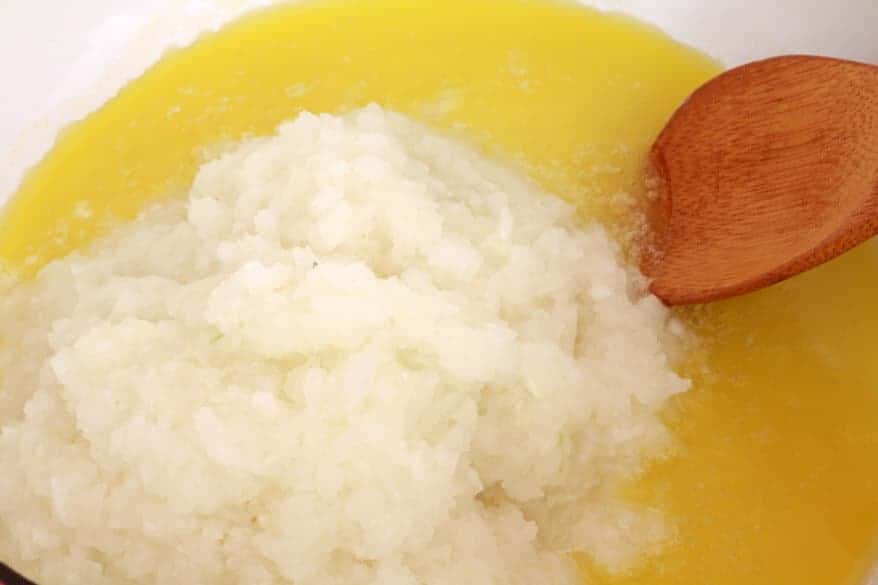
In the meantime, finely mince the garlic and ginger.
Add the garlic, ginger, and 1 tablespoon of butter. Continue to saute, covered, over low heat for another 20 minutes, stirring occasionally.
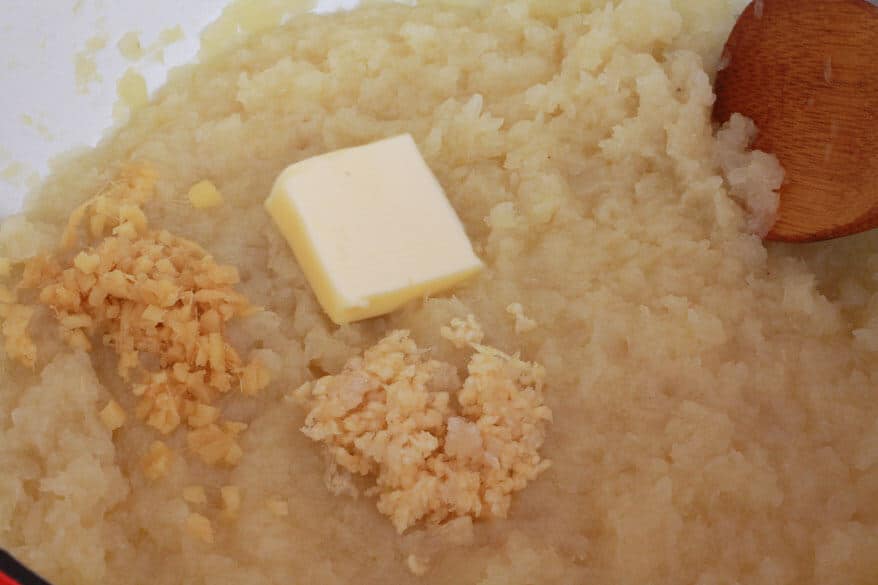
Add 4 tablespoons of berbere and 2 teaspoons salt and stir to combine.
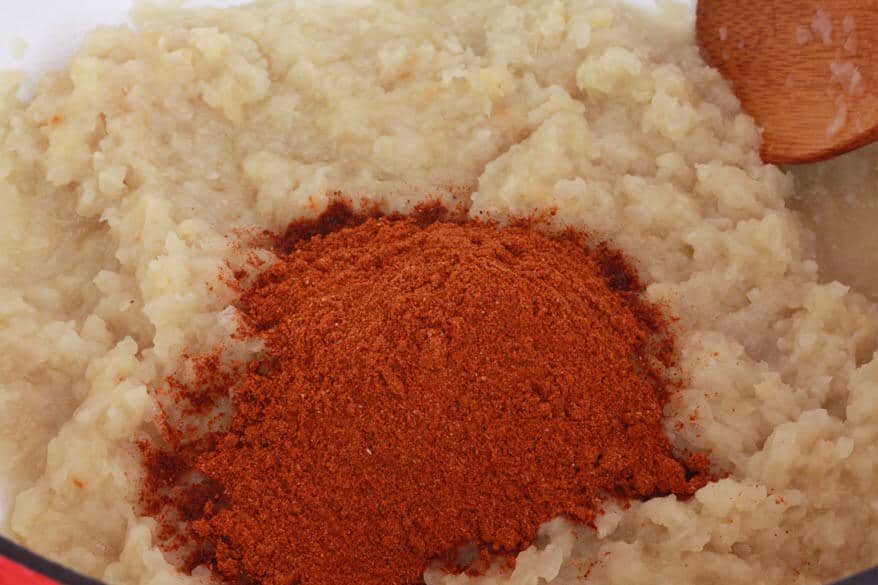
Add 2 tablespoons of butter, cover, and simmer over low heat for another 30 minutes, stirring occasionally.
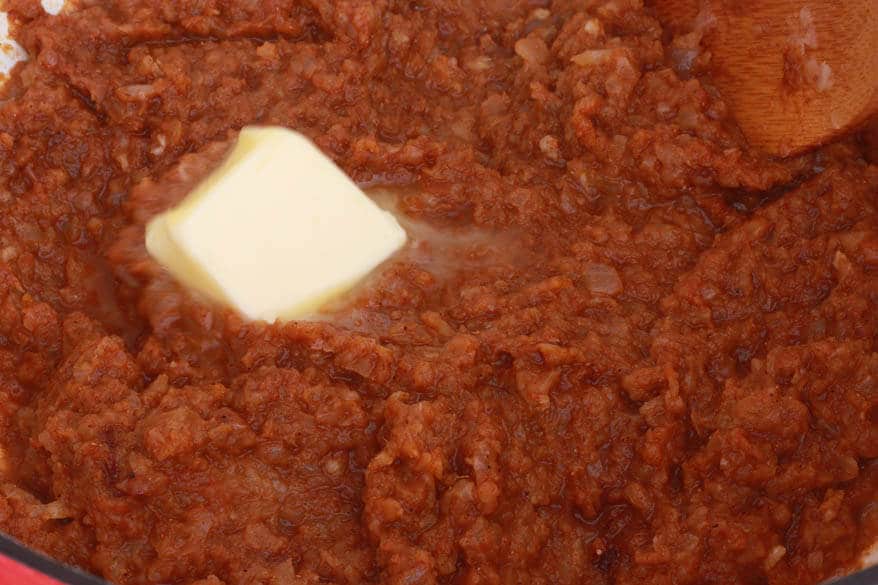
After 30 minutes you’ll have a rich and luscious sauce that’s ready for the chicken!
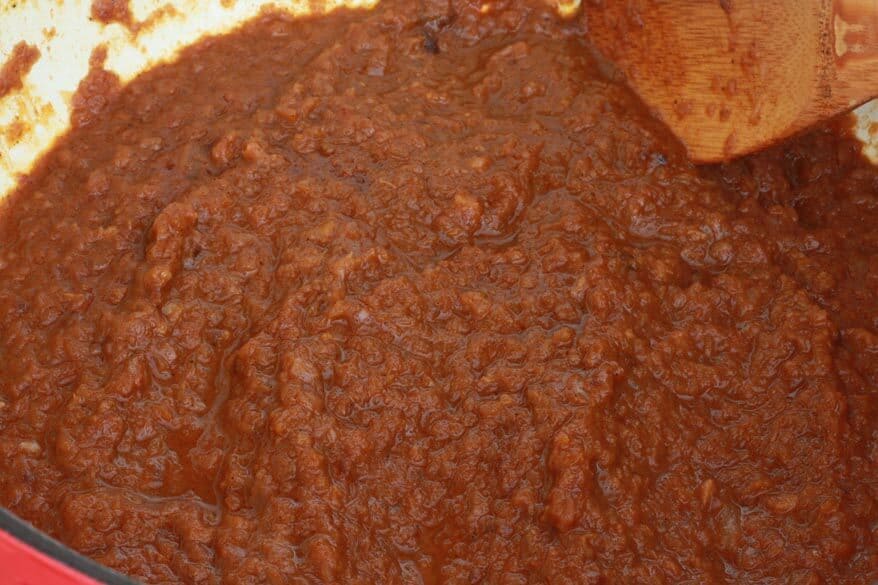
Traditionally, bone-in, skin-on chicken pieces are used. You can either use chicken thighs, cut into 1 inch chunks, or use boneless chicken breast. I used breast this time. Cut the breast into small, 1/2 inch chunks. Place the chunks in a dish with 2 tablespoons lemon juice and let sit at least 15 minutes.
Add the chicken to the sauce.
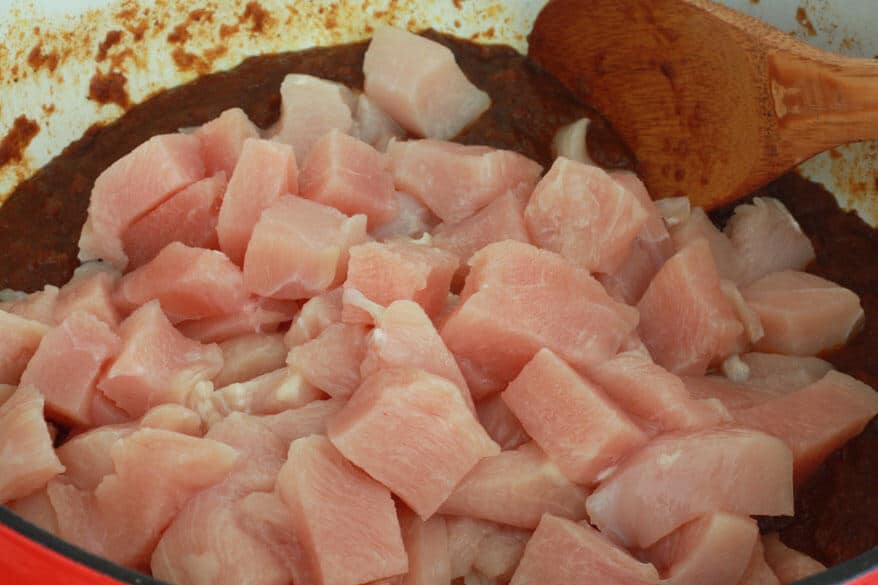
Traditionally, Tej is used, an Ethiopian honey wine. If you have access to it, use it. Alternatively you can substitute white wine with a teaspoon of honey.
Add the chicken stock, salt and honey wine to the mixture. Bring to a boil, reduce the heat to low, cover, and simmer for 45 minutes, stirring occasionally.
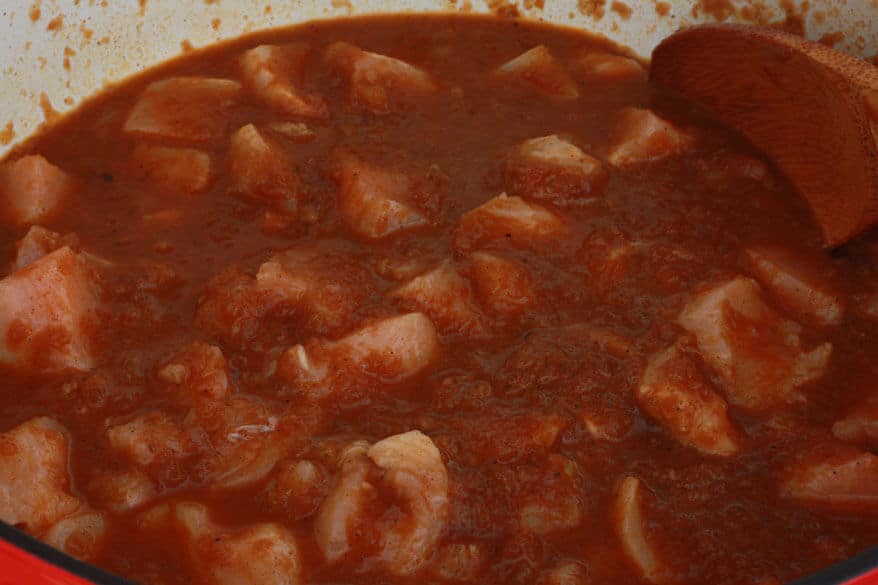
In the meantime, boil the eggs. Once the eggs have cooled enough to handle, peel and pierce them all over with a fork, about 1/4 inch deep, to allow the sauce to penetrate.
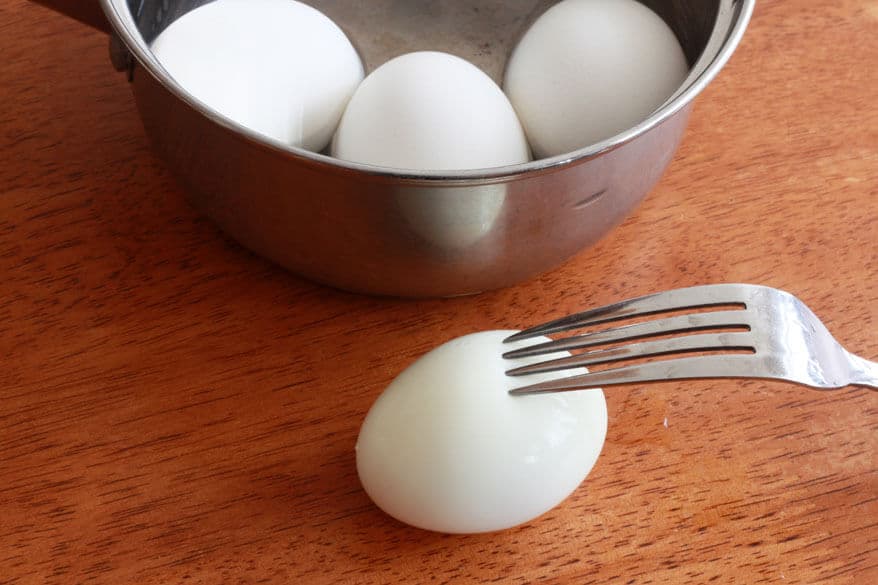
After 45 minutes you’ll have a rich, luscious spicy chicken stew ready for the eggs!
Add the eggs and continue to simmer, covered, over low heat for 15 minutes, stirring occasionally. Adjust the seasonings according to taste. Add more berbere according to heat preference.
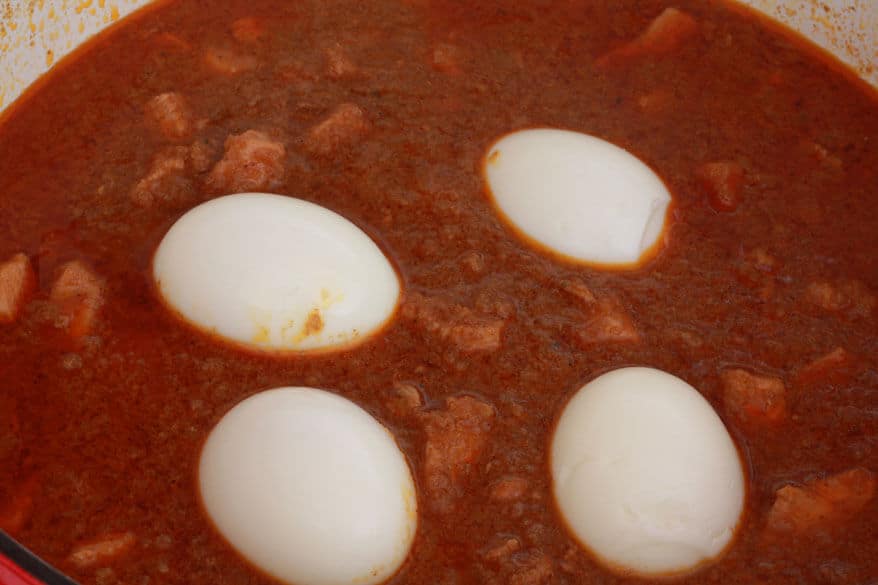

Serve with Authentic Injera (Ethiopian Flatbread).
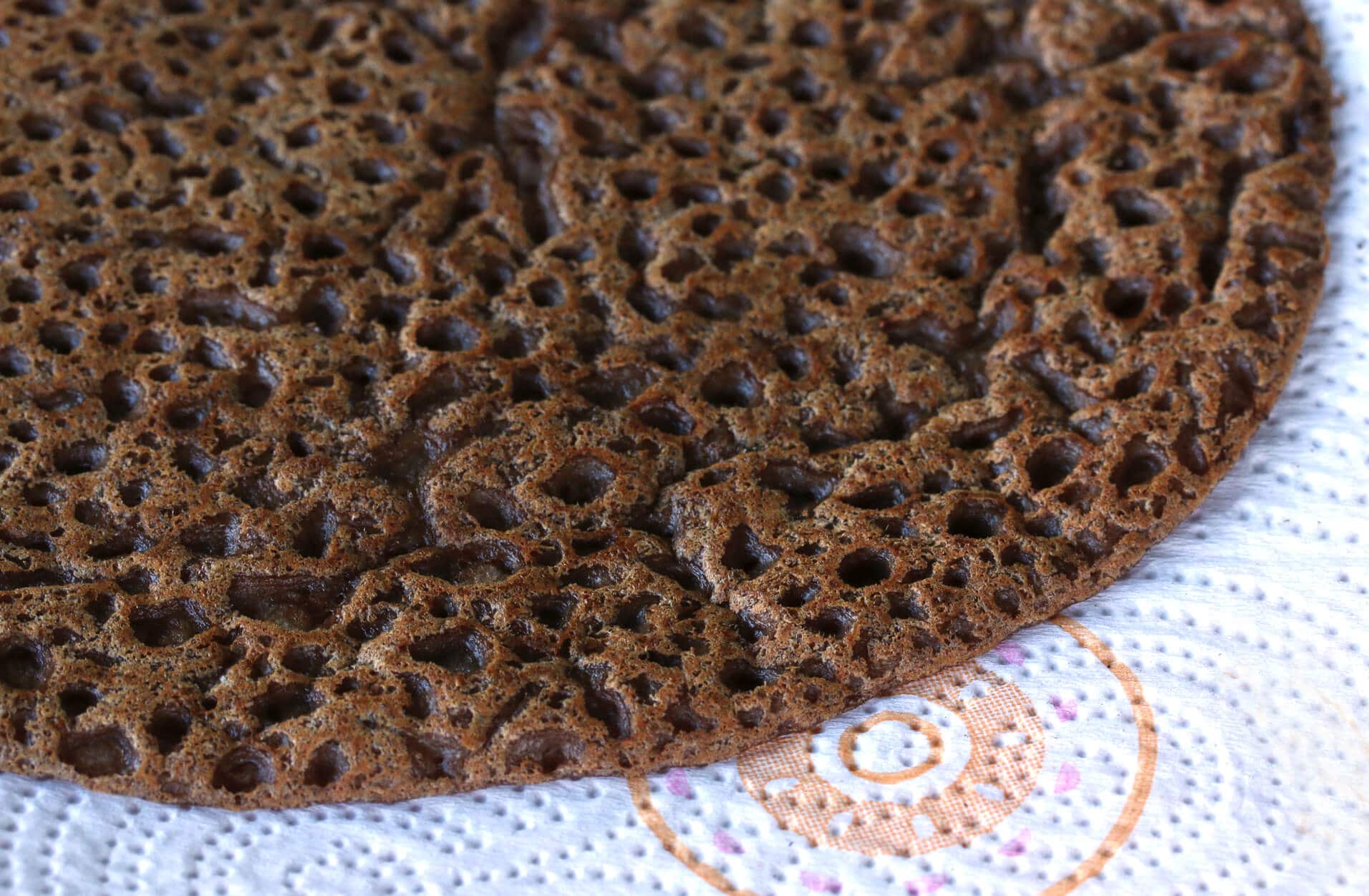
Be sure to also try our authentic Sega Wat, the famous and incredibly delicious Ethiopian spicy beef stew!
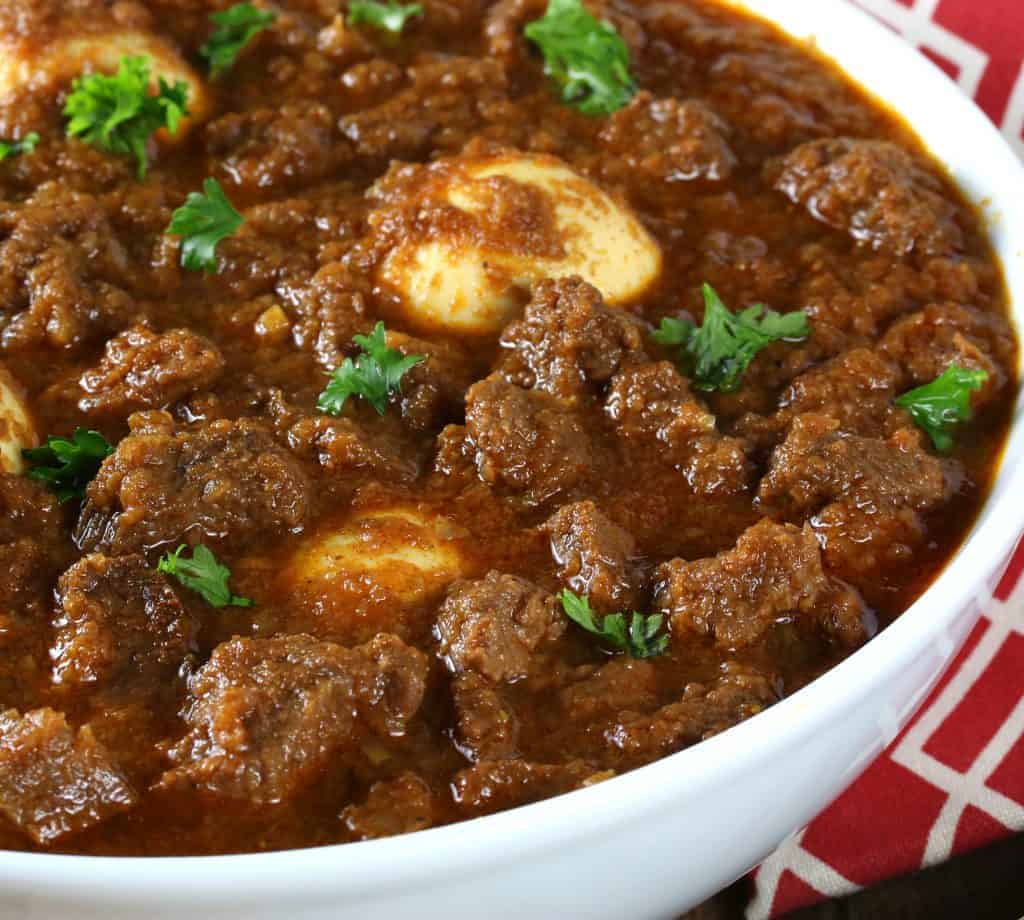
Lastly, for an authentic Ethiopian side dish to serve with your doro wat, try our Gomen (Ethiopian Collard Greens)!
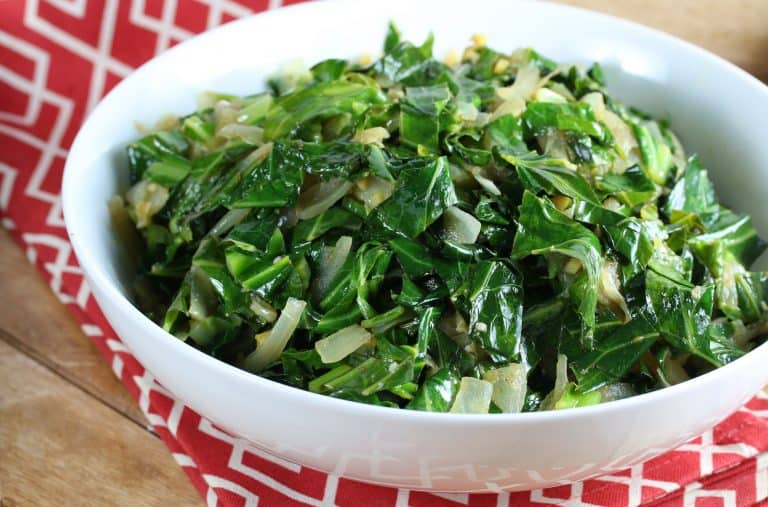
Save This Recipe
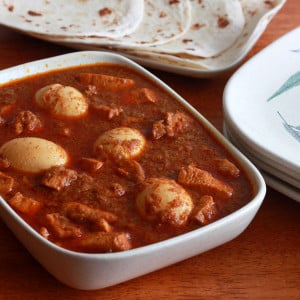
Doro Wat (Ethiopian Spiced Chicken)
Equipment
Ingredients
- 3 lbs chicken thighs , cut into 1 inch pieces, or 3 chicken breasts, cut into 1/2 inch pieces
- 2 tablespoons fresh lemon juice
- 2 tablespoons niter kibbeh
- 2 tablespoons extra virgin olive oil
- 3 cups chopped yellow onions
- 3 tablespoons butter
- 1 tablespoon finely minced garlic
- 1 tablespoon finely minced ginger
- 1/4 cup Ethiopian berbere
- or use HOMEMADE BERBERE (HIGHLY recommended!)
- 1 1/2 teaspoons salt
- 1/2 cup Tej (Ethiopian honey wine) (alternatively you can substitute white wine mixed with 1 teaspoon honey)
- 1 cup chicken stock
- 4 hard-boiled eggs , pierced all over with fork about 1/4 inch deep
Instructions
- Place the onions in a food processor and finely mince them to a chunky puree. Set aside.Place the chicken pieces in a bowl and pour lemon juice over. Let sit at room temperature for at least 30 minutes.
- Heat the niter kibbeh or butter along with the olive oil in a Dutch oven or heavy pot. Add the onions and saute, covered, over low heat for 45 minutes, stirring occasionally.Add the garlic, ginger, and 1 tablespoon butter and continue to saute, covered, for another 20 minutes, stirring occasionally. Add the berbere and the 2 remaining tablespoons of butter and saute, covered, over low heat for another 30 minutes, stirring occasionally.Add the chicken, broth, salt and wine and bring to a boil. Reduce the heat to low, cover, and simmer for 45 minutes, stirring occasionally.Adjust the seasonings, adding more berbere according to heat preference. Add the boiled eggs and simmer on low heat, covered, for another 15 minutes.
- Half or quarter the eggs and arrange on the plates with the stew. Serve hot with injera, bread or rice.
Nutrition
Originally published on The Daring Gourmet August 27, 2013



















Hello! When you say spicy, do you mean “with lots of spices” or very hot?
Hello! Spicy meaning “hot”.
I’ve been looking for a doro wat recipe since I’ve had one in an African cafe here in NZ. It was fantastic! And amongst all the recipes I’ve read, I like yours better.
Hi Dolly – my new best friend! :) Awesome, I’m so glad you enjoyed this and thanks for the compliment. It means a lot. When I develop recipes, I put a lot of careful thought, research, time and testing into them and I’m thrilled to hear my efforts paid off on this one. Thanks again and I hope you’ll try some others!
Delicious but not authentic!
:-)
How so, Rebecca?
I agree with Rebecca on this one. You have great understandings of our spices. I actually used recipe for fun and it is delicious! However, it tastes a lot different than what an authentic doro wot would taste like. Little tip, don’t put ginger or Tej. Some people use wine but only when cooking tibs.
I made this today–it was *so* good. I ordered the suggested berberre from Amazon. I think the pureed onion is key for the texture though. Thank you so much for sharing!
Hi Kim, that’s fantastic! It was hit in my family as well – even my 3 year old loved it! Yes, I’ve noticed that some recipes call for pureeing the onions. I didn’t simply because traditionally authentic doro wat doesn’t puree them – that’s a modern adaptation – and I wanted to create a recipe that was as true to authentic roots as possible. But there’s certainly no right or wrong otherwise – purely personal preference. Thanks so much for making this and for your feedback! A lot of people fear getting out of their culinary comfort zones and often because an ingredient is unfamiliar, or because it’s a foreign dish from a country far away, they’re too afraid to make the dish. With so many of the international dishes on my site, if I were to take out the real name of the dish, any reference to its being foreign, and just name it something “everyday” (e.g., “Spicy Chicken in Onion Sauce”), guaranteed more people would make it. My hope though is that by providing step by step photo instructions and talking about the dish, any elements of “mystery” will be removed, the dish will feel more approachable and accessible, and people will have fun trying it! In any case, whether you’re a seasoned international cook or whether this was a bit of a step in the dark for you, I’m so glad you made it and thank again for taking the time to leave some feedback!
Is that brand of berbere nice and spicy? I love Ethiopian food :)
You know, I’m really not sure just how spicy that particular brand is, or any other brand for that matter. I’ve been making my own spice blends for years and haven’t tried store-bought of anything for a long time. What I’d suggest is that if you find that the stuff you buy isn’t quite spicy enough, simply add some more chili flakes or cayenne pepper at the end of cooking and taste to determine if you want more or not. That way you’ll still have the flavor from the spice blend but can adjust the heat according to your preference.
Could you please check, there seems to be something wrong in the recipe, it repeats a few steps! Also, the fenugreek and cardamom from step 8. are not mentioned in the ingredients list, do I still add them if I use store-bought berbere?
Thanks,
Jelena
Hi Jelena! Thank you for noticing that – I’ve just corrected it. Enjoy the Doro Wat!
Thanks, I’m going to make it tonight, I can’t wait. Thanks for the great recipe!
Thank you for making it, Jelena! Let me know what you think!
Looks just fantastic. I have been on the lookout for a Doro Wat and Berbere recipe and I have hit the jackpot. Will have to give this a try soon.
Thank you so much, Daily Musings, and for the visit! We really enjoy this dish. Please let me know what you think once you’ve had the chance to try it!
Just stumbled across your blog on Foodgawker and it appears we both have a passion for global food and spices. Love the range of your recipes and this one looks absolutely divine. Quick question for you ‘what is a Dutch oven’? Lost me there? Will definitely be trying this in the Autumn. So glad I found your blog. Best Torie
Hi Torie, so glad to meet you! I just popped over to your blog and after perusing it for a minute am impressed! I look forward to spending more time there. I see you’re from England. I grew up in Europe and had the pleasure of living in England for 6 years near Peterborough – I’m really homesick. To answer your question, a Dutch oven is the term used here for a thick cast iron pot with a lid. Elsewhere it’s also referred to as a “casserole dish.” Any heavy pot with a fitting lid will do the job. Thank you for visiting! I’m happy we’ve connected and I look forward to spending more time on your blog! Cheers, Kimberly.
ah that makes sense re Dutch oven. Thank you for the clarification. Hope you are not too homesick for England, am sure you can get marmite and scones with jam and clotted cream over in the US too right ;o) ? Will definitely enjoy looking through your blog in more detail. Best Torie
Haha! You know, it’s funny you should mention marmite. We actually have two jars of it that we picked up several years ago and have just never eaten it (I’ve never been a fan I will admit). My husband, feeling courageous, opened up one of the jars (like 4 years expired!) and spread it on his sandwich. He took a bite and announced, “Marmite never goes bad!” No, Torie, I don’t think all the marmite, scones, or clotted cream in the world will satisfy my longing for a much overdue visit! In the meantime I’ll just have to be satisfied with pictures and memories.
I feel the need to comment about the Dutch Oven. Coming across this site and this thread has been great and so nostalgic since my best friend in school was Eretrean and this recipe really makes me feel like a kid again. Please understand that the following comments are not meant to be inflammatory, instead they are meant to be informative, especially since this site seems to be about cooking. BUT … I’m sorry, a Dutch Oven is not a casserole dish. A Dutch oven IS a cast iron pot with a lid, typically with a lip around the edge on the outside. They are typically made this way so that they can be inserted into hot coals and have hot coals or stones placed on top of the lid, the lip preventing them from sliding off, thereby turning the utensil into an oven. There are many different recipes for utilizing this device. Try Googling “Dutch Oven Cooking”. Of course this is not the only way to use a dutch oven as I have often cooked roasts and fowl in them as well. Provided the iron is properly cleaned and ‘seasoned’ this is one of the best way to do slow cooking.
I’m not sure what the misunderstanding is, Lahru, the definition I provided is the same as yours: “a thick cast iron pot with a lid.” Knowing the particular location of the reader I responded to, I also mentioned that in the UK (where I lived for 7 years) cast iron pots are sometimes also referred to as “casserole dishes” and that is also true. Check out the UK’s Amazon site and type in “casserole dish” and you’ll find multiple cast iron pots like the one discussed here.
This sounds wonderful. I’ve seen recipes for this before and not been really interested until now. I really appreciate your explanation of what you are trying to achieve when cooking this. It seems like a LOT of fat added (I’m not phobic about fat but do have to pay attention to overall calories). I also love the photos of Ethiopia – they remind me of driving through parts of Utah. Have you been to Ethiopia? I’d love to see that countryside in person. And try the food. :-)
Thank you, jesusan. I know, I was thinking the same thing about how much Ethiopia reminds me of southern Utah! Almost identical landscape and rock formations in areas. I’ve been to Utah several times, but never to Ethiopia. Would love to visit – and eat – as well ;)
There’s about 1/4 cup of butter in this recipe and 2 tablespoons of olive oil, which isn’t too awfully scary considering it’s divided between 4 people/servings. Plus, if you use chicken breast, that’s lean. In any case, it’s WAY less than many Ethiopians use! Some versions I’ve seen, they just keep scooping and scooping it in! Well, they know what tastes good, right? But yes, I like to be at least somewhat mindful of fat content as well. But oh, how I love butter! Reminds me of Julia Child quote: “If you’re afraid of butter, use cream!” :)
Thanks for the laugh, Kimberly. The Julia Child quote certainly does give a different perspective, doesn’t it? I love southern Utah, especially Arches National Park. Oh well, must get back to my mesquite flour making project. Cheers! Susan
We were just in southern Utah last month for a family vacation. We saw Goblin Valley State Park for the first time and it was amazing. Absolutely incredible. Will be posting some pictures just as soon as I have time to edit the pictures (HA!).
Okay, “mesquite flour making project”…DO tell!
Mesquite flour project. We have a couple of honey mesquite trees in our front yard that produce pods prolifically. I discovered that they are edible, so I did further research and learned how to make flour from them. The flour gives a sweet taste to whatever you use it in, and it is amazing in whole wheat tortillas and cornbread. It is a real pain to make the flour, especially when it’s humid the way it is here now (60% – very high for the desert), but thanks to my trusty Magic Bullet, I’ve been getting it done. There is some debris left over, and it takes several grindings to get the hard seeds ground. They are important because they are a source of protein. The problem with humidity is that the pods are very hygroscopic, and when there is too much moisture in the air, the flour sticks to everything. You can get mesquite flour, also known as mesquite powder, commercially – I’ve seen it online imported from Argentina. It is rather expensive to buy (a real good reason to make it, because we live on tortillas these days, and they just aren’t the same without mesquite). If you get any, I strongly recommend storing it in the freezer, so it doesn’t go rancid. It is usual to substitute 20-25% of regular flour with mesquite.
We will have to check into Goblin Valley State Park. I’ve never heard of it before. I will look forward to seeing your edited photos – and I’ll be happy to get my whip out to encourage you, if that would help… :-D
Yikes, I’ll try to get a move-on with those photos!! We were unfamiliar with it as well, even my dad was and he grew up just an hour and half away. It’s a lesser known state park, which is very surprising – it’s honestly one of the neatest things I’ve seen. Extremely unique and fascinating how those alien-like rock formations came to be.
The mesquite flour sounds so fascinating!! I’ve never heard of it before! I just looked it up and have been doing some reading about its health benefits. It looks like 76% of the mesquite plants in the US are in Texas. My husband is from Arizona. Next time we’re down there I’ll need to go mesquite plant hunting and see if there are any to be found there. That is really neat that you’re able to access so many of those pods and make the flour yourself! And even with the sticky mess, I’ll bet all the work is well worth it!
There is a group in Tucson called Desert Harvesters that has a machine that will do the grinding for you. I know they have mesquites in that area, at least. The pods you are looking for are beige, with some small dark purple splotches. You want fat beans without wormholes. At least in El Paso, most of the native ‘trees’ are really bushes, and they are honey mesquites. If you break a pod open and check the scent, it should be sweet. They remind me a bit of snicker doodles cookies. If you can pick pods from the trees rather than pick them up off the ground, that is preferable. If you do find some pods, I’ll be happy to coach you through the process of flour making, if you don’t find someone to do it for you.
A question about Goblin Valley State Park: is it completely primitive or do they have real bathrooms available? That could make a difference in whether or not I go there… :-)
Thank you so much for the info! I asked my husband about the mesquite trees and he said he always saw lots of them in the Mesa/Phoenix area. He said they grow wild and people also plant them in their yards. He remembers seeing all the pods. I am so intrigued and appreciate you sharing all of this information with me! I’m not sure when we’ll be in Arizona next, but when we do go I’ll know what to look – and smell – for :) Thanks!
Yes, there are real bathrooms at Goblin! :) There’s a building with toilets anyway, I can’t remember whether they’re the flushing kind or not…but there are definitely amenities beyond those provided by Mother Nature.
Thanks, Kimberly. FYI, August and September are when you find the mesquite pods.
Perfect, I was actually just trying to find that information online. Thanks again! :)